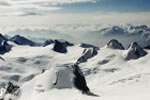


 |
 |
 |
Kames and Kame Terraces
Kames are mounds of sediment which are deposited along the front of a slowly melting or stationary glacier / ice sheet. The sediment consists of sands and gravels, and builds up into mounds as the ice melts and more sediment is deposited on top of old debris. Often, a kame will collapse when the ice melts back and leaves the mound unsupported.
Kame Terraces are also composed of sands and gravels, but form along the sides of the glacier rather than at its snout. They are formed by the actions of meltwater streams that flow along the sides of the ice, trapped against it by the valley walls. As the valley walls warm up in summer the warm rock helps to melt the ice nearest to it, forming a long depression or trough along which meltwater flows. Because the deposits in a Kame Terrace have been transported by water, they become sorted, enabling them to be distinguished from lateral morain deposits which exhibit no sorting.
Kettle Holes
These are formed by blocks of ice that are seperated from the main glacier by either the glacial ice retreating or by blocks calving off the glacier snout and falling forwards. If conditions are right, the isolated blocks of ice then become partially buried in meltwater sediments. When the ice blocks eventually melt they leave behind holes or depressions that fill with water to become Kettle Hole Lakes. In freshly glaciated areas, Kettles form obvious small lakes in the outwash plains. In areas glaciated in historic times they may be preserved as isolated small lakes, or deep water filled depressions in boggy areas that were once the low lying outwash plains.
We value
your ideas and suggestions. Please contact the
maintainer of this site.
This page
can be found at: http://www.geography-site.co.uk
Last update to
this statement was on:
February 23, 2006
© Copyright Geography Site